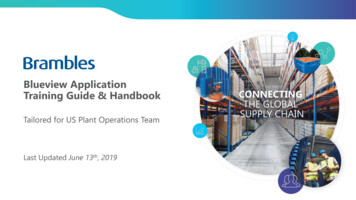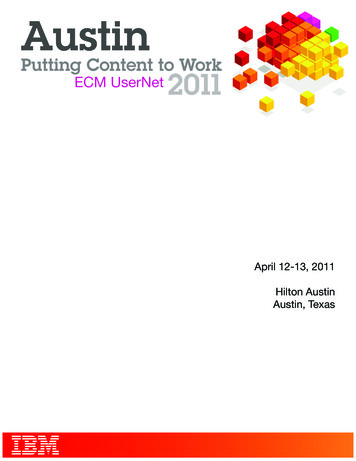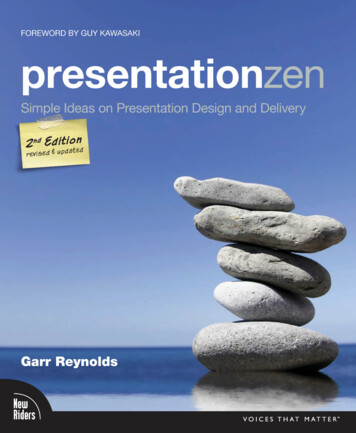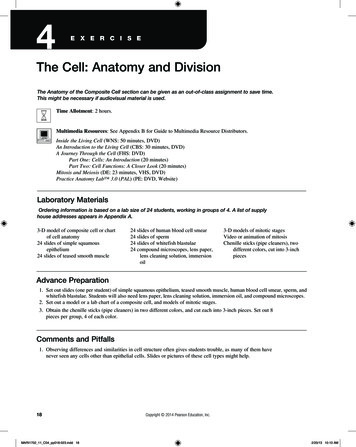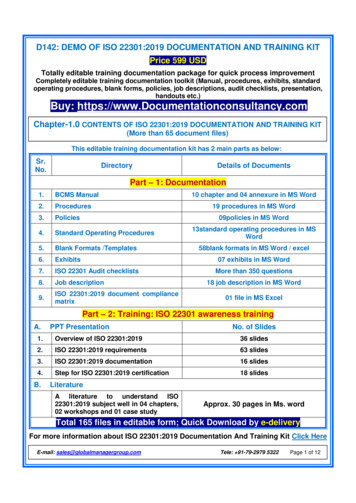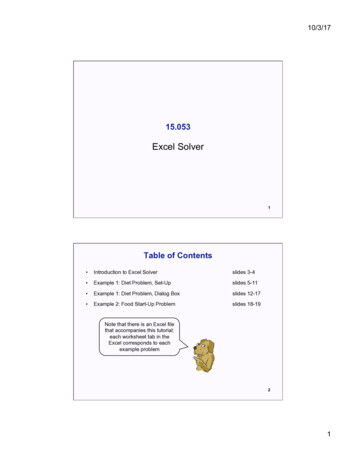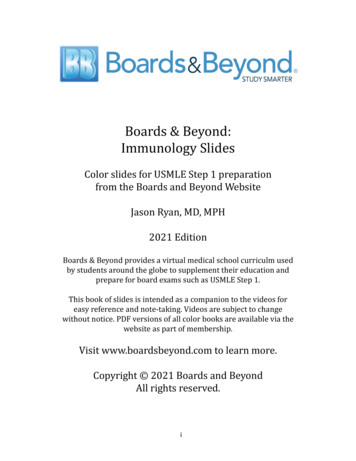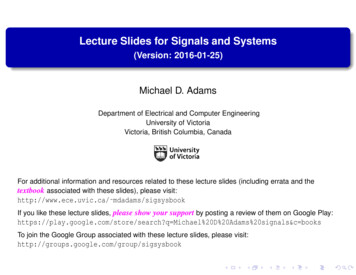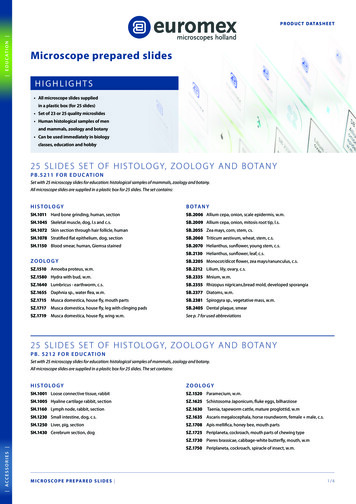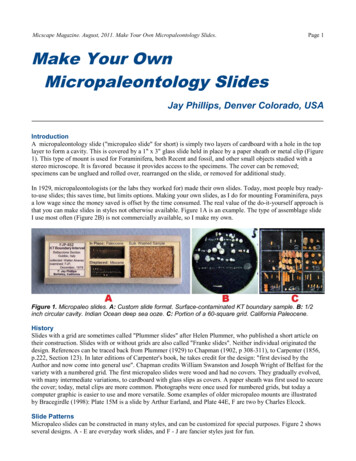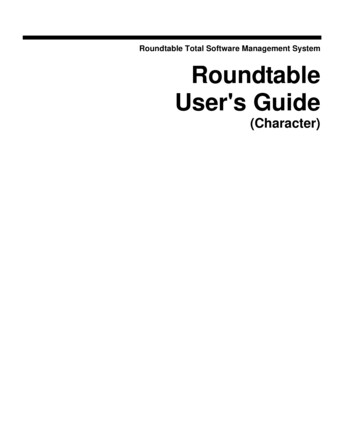
Transcription
Martha Aja, DublinDorothy Killingsworth, Alameda CountyPeter Schultze‐Allen, EmeryvilleMarie Arnerich, EBRPDSteve Myli, EBRPDMax Gara, Oakland Unified SDNancy Deming, Sustainability Initiatives Program Manager, Oakland Unified SDMarcy Greenhut, EmeryvilleJennifer Feeley, PiedmontBraxton Banks, Independent consultant to schoolsKaren Cook, Alameda CountyRachel Balsley, StopWaste.OrgDelyn Kies, Consultant to StopWaste.OrgSusan Kinsella, Conservatree1
‐ A participant asked about what time of day janitorial services should be provided forbest results and environmental benefits, such as minimizing lighting use and otherbuilding energy and efficiency outcomes.‐ Typical work schedule for Alameda County janitorial staff is 5am to 1pm. This providesthe following benefits:‐ 2 to 3 hours to do noisy work (like vacuuming) before majority of buildingoccupants arrive‐ Janitors get to know staff, are part of work community – this builds trust andallows for two way communication‐ Reduces lighting and building HVAC energy use because building systems canremain off for more hours of the night‐ Exceptions – From 6pm to 2am a small night shift crew rotates through thebuildings doing floor care work. Also, from 1pm to 9pm, there is a day portershift that rotates through the buildings handling emergencies or doing specialprojects. Each of these shifts is approximately 1 person for every 8 to 10buildings.‐ EBRPD uses a similar hybrid system of day and night cleaning for services in theiradministrative properties – mostly daytime service for shared areas and non‐disruptivefunctions with some nighttime crews for floor care duties2
3
Santa Monica documented a 5% reduction in cost when they transitioned to greencleaners.Controlled dilution systems limit overuse of chemicals and can contribute to reduced costs.4
5
6
7
Green Seal and EcoLogo are both approved for meeting ISO 14020 standards that includethese criteria.8
‐ There are thousands of Green Seal certified products available from hundreds ofmanufacturers.‐ Some common Green Seal product standards for cleaning products include:GS‐37 for General Purpose CleaningGS‐34 for Cleaning and DegreasingGS‐40 for Floor Care Products For Industrial And Institutional UseGS‐41 for Hand Care Products For Industrial And Institutional Use‐ Up to 27 Health & Environmental criteria including toxicity, carcinogens, skin irritants,inhalation toxicity, and concentrates and dosing ‐ in product and as used.‐ The Green Seal Cleaning Services standard (GS‐42) only has 2 certified vendors inCalifornia. Instead of requiring vendors to have the certification as part of your contract,review what is in the standard and ask your vendor which of the practices they use andwhich they could implement, based on your agency’s priorities and policies. The standardcan be found at the weblink on the slide.9
‐ Similar to Green Seal, many certified products made by many companies.‐ Note that the UL/EcoLogo standard documents all begin with CCD, which stands forCertification Criteria Document.‐ Some of the common UL/EcoLogo standards for cleaning products are:‐ CCD‐146 Hard Surface Cleaners‐ CCD‐148 Carpet and Upholstery Cleaners‐ CCD‐147 Hard Floor Care Products‐ CCD‐104 Hand Cleaners‐ CCD‐170 Instant Hand Antiseptic Products10
An “ingredient‐based analysis” does not also consider product use. DfE allows non‐concentrates meaning potential overuse of chemicals and increasedcosts, i.e. more packaging, more shipping costs and waste, and more required storagespace. “Renewable resource” is problematic as criteria for paper products because it can beinterpreted to allow any forest product, including old growth trees. Requiring recycledcontent that meets at least the EPA minimum recycled content standards is best. Morediscussion at Slide 26.11
Purchasers need only specify in bids or request from vendors Green Seal and/or EcoLogocertified products for their cleaning needs.12
These agencies provide bid documents and/or contracts, or excerpts of the specificlanguage used to specify green products. Even if you don’t formally bid, this informationcan help inform your conversations with your suppliers or janitorial services providers.13
‐ These best practices, among many others, are included in Green Seal’s Commercial andInstitutional Cleaning Services standard (GS‐42). The standard document is available forfree download from Green Seal www.greenseal.org and is a great resource foridentifying best practices for your own cleaning program or for your cleaning servicesvendor.14
‐ The U.S. is the largest tissue producing region in the world, and also uses the most.‐ Top at‐home brand is Charmin which contains no recycled content (Kimberly‐Clarkowned) but many others do contain some recycled content, even if they don’t label it.‐ North American away‐from‐home market has a number of smaller manufacturers likeBay West, SCA, and Marcal, in addition to the large players listed in this slide. There arealso “rewinders” – companies that take huge rolls from manufacturers and cut themdown for private label.‐ Several U.S. tissue manufacturers have been investing in their facilities, including addingmore recycling capacity.‐ Some foreign papers marketed as renewable come from plantations that were createdby clearing and burning old growth forests in Indonesia. For tissue products, ask forrecycled content, not “renewable”. (See Slide 26 for more information.)15
16
‐ Studies show that converting from paper sheets to roll towels saves money and reducespaper use.‐ Rechargeable batteries can be used in hands‐free dispensers. It is a cultural changebecause you need to organize processes for regularly recharging the batteries and trainstaff not to throw them away as if they were disposables, but they are a huge cost saver.San Jose airport found they were replacing the four D batteries required for each hands‐free towel dispenser every month and could achieve big savings by replacing them withrecharged batteries on a regular schedule.17
Coreless rolls use a reusable plastic spindle that is inserted into the center of the roll.‐One participant shared that the spindle can be difficult to insert into the center of somerolls. It can take more time to load them than using regular core toilet paper.‐However, with double the sheet capacity, it’s likely that total labor is smaller because lessrefilling is required.‐One spindle may not fit all dispenser types, especially with the variety of proprietarydispensers. It is recommended that you pilot test the spindle with each dispenser type inyour agency. Also, there may be several spindle sizes that your vendor can provide, so askyour vendor.‐Small‐core also reduces waste, but not by as much as the coreless. It is basically just asmaller core size than standard cores.18
‐ EPP tissue products are made from the same fibers as recycled office and printing paper.Tissue products and office paper made from tree fibers use the most resources of allpaper types, so they are especially important to buy with recycled content. Tissuemanufacturing can also use shredded office paper.‐ There is a big push to look for multi‐attribute benefits. But because the papermanufacturing process is so energy, water and chemical intensive and recycling reducesthe need for all of them, buying recycled content products results in significant multi‐attribute resource savings.‐ Recycled content product manufacturing is the most comprehensive way to rapidlyreduce the manufacturing “footprint” for making paper.‐ The only mills in North America producing tissue (as well as printing and office paper)bleached in totally chlorine‐free processes are recycling mills. (Not all recycling mills arePCF – processed chlorine free – but most are.)19
You can find the U.S. EPA’s comprehensive procurement guidelines at: issue.htm . “Standard, not certification” means that criteria are set for labeling a product as recycled,but there is no EPA verification. EPA includes ranges in the recommendations because they encourage buyers to purchasehigher than the minimum recommended levels whenever possible.20
Green Seal has been re‐certifying all previously certified tissue products to the higherstandards of 2011. Green Seal requires 100% recycled content AND postconsumer content levels slightlyhigher than the U.S. EPA minimums standards.‐An alternative allows up to 85% agricultural residues. While currently there are few suchtree‐free tissue products, it is expected that new tissue products with non‐wood fibers willbe introduced so there will be more in the future.‐Selecting Green Seal products also provides verification that manufacturers are usingbleaching processes that are free of chlorine and chlorine‐derivatives (PCF).21
It’s a good idea to verify products’ certification claims, especially on bids. Don’t acceptclaims for products that are still in the application process, or that have expiredcertifications. You can verify Green Seal certification by making sure the product is listed on the GreenSeal website. This slide shows what the website verification looks like.22
‐ UL/EcoLogo goes about certification in a completely different way.‐ Rather than telling the manufacturers exactly what environmental attributes theirproduct must have, UL/EcoLogo tells them that the goal is to minimize their productionfootprint enough that they can be below a low level of “load points.” This gives flexibilityto manufacturers on how they want to achieve the certification.‐ Standard does not require recycled content, but UL/EcoLogo says it is very hard toachieve the certification without it. Due to this, however, it is best to require minimumlevels of postconsumer content consistent with the U.S. EPA CPG (see Slide 20), even ifyou are specifying UL/EcoLogo.23
It is easy to verify that a product is certified by looking it up on the EcoLogo website.24
Other environmental attributes you may want to look for, or may notice on the productsyou buy include:‐FSC certification – This ensures that any virgin wood content has been sourced responsibly.FSC also certifies some recycled products.‐The type of bleaching used on the pulp is important, and especially for tissue products.While the bleaching done in North America is much better environmentally than it used tobe, the safest option is to use completely non‐chlorine bleaching agents like ozone, oxygenand peroxide. The only tissue (as well as printing and office paper) mills doing that are(most of) the recycling mills. They will list “PCF” on their labels or product description.‐It can be even better for the pulp to not be bleached at all. But, ironically, some of thebrown paper you see has actually been bleached and then dyed back to brown.‐CFPA certification – This certifies that the product was bleached without chlorine orchlorine derivatives, i.e. that it is process chlorine free (PCF).‐Tree‐free fibers – While this is an emerging trend to watch, it’s still best to specify recycledcontent for now.25
‐ The USGBC LEED for Existing Buildings O&M has a number of points available related togreen cleaning.‐ Even if you don’t pursue LEED for Existing Buildings, the requirements for a high‐performance cleaning program provide an excellent overview of what to consider ingreening your operations. An overview of the credit can be found at:new.usgbc.org/node/1731404?return /credits/existing‐buildings/v2009 .‐ It is very complementary to the Green Seal Cleaning Services Standard (GS‐42, see Slide9 for more information).‐ Be wary of tissue product companies that claim environmental benefits due to “rapidlyrenewable” resources (as allowed for in LEED). Don’t confuse “renewable” with“recycled” – the paper industry considers trees to be “renewable” and there are papercompanies destroying forests in Indonesia, especially, to produce tissue and paperproducts that are then labeled “renewable.” Insist on recycled and postconsumercontent instead.26
Here are the top three things you can specify for your products, with recycled contentbeing the most important. Tissue products researched for the City of San Francisco in summer 2012 found that thereare many tissue products nationwide that can meet all three.27
‐ The product types listed here have sufficient products available and/or numerousproduct vendors to ensure a competitive bid.‐ See next slide for exceptions.28
‐ Here are some exceptions where the certifications may not provide adequatecompetition.‐ Also, correctional facilities and hospitals may have special circumstances that need to beconsidered prior to making changes to products.‐ Remember that if you go below 100% recycled, you should see if you can get FSCcertification for the virgin fiber, too.29
GREEN TEAMS:‐While useful in all agencies, green teams can be particularly successful in agencies wherepurchasing is completely decentralized with each department doing its own purchasing.‐Several local jurisdictions have used green teams successfully to educate, test, and specifygreen products as a group to implement green purchases across all departments in the City.ASSIGN RESPONSIBILITY:‐Setting reasonable, achievable and measurable goals or targets, and then tracking progresstowards them, can be an effective way to motivate behavior change.PURCHASING:‐Leverage the work of other agencies by piggybacking.‐If writing your own contracts, learn from others who have already done it by reviewingtheir bids.‐To get best pricing, make vendors bid on green products by listing these as your core‐product list and removing products that don’t meet your environmental criteria.‐Pilot test products to ensure they work in your environment. Include line staff and/orcustomers in the product testing and ask for their input. (Be sure to train them on how touse the products correctly, since often they require a new process.) If at all possible, askstaff to use up any product that is pilot tested, even if it is not ultimately selected, so youdon’t waste it.30
EDUCATE:‐ Use existing communication methods for quick tips, getting user feedback and lettingemployees know why and how new products are being evaluated and/or purchased.TRAIN:‐Remember that when switching to green cleaners, you need to train staff on a new way ofdoing cleaning. They often do not work in the same way as traditional cleaners.‐When contracting for cleaners, ensure your contract requires initial and ongoing trainingby the vendor.‐The Alameda County contract requires unlimited training. This is particularly useful whenwe need to troubleshoot a location that is getting complaints. Retraining staff oftenaddresses the issue.TRACK:‐It can be useful to track metrics on product use in order to monitor ongoing performanceof your green purchasing initiative, promote cost savings, or promote your greenpurchasing program success to your elected leaders and your community.‐You can also integrate sustainability performance metrics at a staff or organization level.PROMOTE SUCCESS:‐ Build momentum for your programs by promoting your successes and recognizing keystaff efforts.31
‐ Alameda County makes the environmental language from many of its green bidsavailable on our public facing website listed in the slide.‐ Sustainability staff is available to provide technical assistance to local public agencies.Please do not hesitate to request assistance!32
StopWaste.Org has published a number of guides and factsheets that serve as a resourcesto green purchasers locally and nationally.The 2013 Update of the Green Maintenance Guide is available for download at the weblinkin the slide or by requesting a printed copy from Rachel Balsley (see Slide 35 for contactinformation).33
Conservatree is recognized nationally as a leading voice for sustainable papers.34
35
‐CFPA certification -This certifies thatoduct the pr was bleached without chlorine or chlorine derivatives, i.e. that it is process chlorine free (PCF). ‐Tree ‐free fibers - While this is an emerging trend to watch, it's still best to specify recycled content for now. 25
